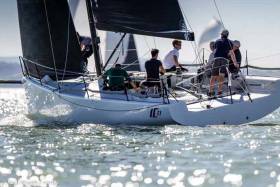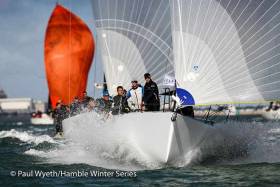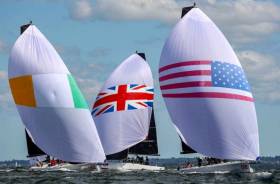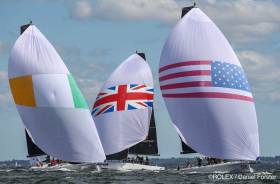Displaying items by tag: IC37
In just a few short years, the IC37 from the drawing board of County Wicklow's Mark Mills has reshaped the landscape of big-boat sailing.
As the chosen class for the Rolex New York Yacht Club Invitational Cup and the Canada's Cup, two of the world top sailing trophies, and the preferred one-design for top Corinthian sailors in North America and Europe, the 37-foot Mark Mills design has carved out a sizeable niche in the sport.
To help the class take the next step, and equal some of the great one-design keelboats in the history of sailing, the IC37 Class Association has signed an exclusive brokerage partnership with Thoroughbred Yacht Sales, a leading source for high-performance race boats for more than 30 years, with more than $100 million in total sales.
"We want to thank Harry Melges, Andy Burdick, and the entire team at Melges Performance Sailboats for their considerable contribution to the creation of the IC37 and development of the IC37 Class Association," said New York Yacht Club Commodore Christopher J. Culver, a devoted IC37 sailor. "With a 20-boat fleet at the New York Yacht Club and the further construction of 15 private boats, the IC37 Class is ready for the next phase in its international growth in partnership with Thoroughbred Yacht Sales."
The IC37 class was created in 2018 by the New York Yacht Club in partnership with industry leaders Mills Design, North Sails and Melges Performance Sailboats.
Meanwhile, another Mills design, the smaller Cape 31 craft looks set for Irish shores next season with four boats already ordered for Cork Harbour, Dun Laoghaire and Howth.
New Melges IC37 in Build for Spring Delivery on the Solent
Solent yachtsman and Rear Commodore of the Royal Yacht Squadron, Bertie Bicket has announced that his latest Fargo is to be a new Melges IC37. Currently under construction at Fibre Mechanics in Lymington, she is due to be delivered in the spring.
Speaking from Auckland, Bertie comments: “After a lot of searching and evaluation of what’s out there, the IC37 simply ticked more boxes than anything else on the market. At the smaller end of the scale there are options, but I didn’t want a big dinghy and was looking for a proper race boat, that could handle tough Solent days out and maybe also go offshore, so ultimately these boats were head and shoulders above others.
As regular Afloat readers will know, the IC37 is from the design board of County Wicklow's Mark Mills and it is the boat in which Royal Cork's Anthony O'Leary and crew took bronze at the 2019 New York Yacht Club Invitational Regatta.
“Having competed in the New York Yacht Club Invitational Regatta in 2019, I know just how much fun these boats are and to have a growing international one design class to compete in makes the IC37 a compelling proposition,” Bicket added.
With additional endorsement from the NYYC, who were the brains behind the IC37 concept, securing another UK boat will prove a great steppingstone for the development of this class over the coming years in the UK and we all know that one design boats, which have a second life in handicap racing, are here to stay.
“Having studied the on-board systems and ethos of the design, it is a substantially cheaper option in terms of running budgets and bang for buck, so we’re incredibly excited to get back out there and hope a few more boats might join for some close level rating sailing,” continues Bertie.
Fargo and her crew of ‘Solent legends’ are expected to put on a good show with their new and optimised steed.
Reflecting on feedback from existing and potential owners, the 2021 season will see some changes to the UK class.
The success of ICY, owned by veteran Solent one design campaigner Ian Atkins, in its first year while racing under IRC has ensured interest in the IC37 continues to be strong. To further encourage that interest, the IC37 will race with an IRC orientated sail wardrobe as well as a couple of other changes to increase its IRC competitiveness.
“Despite only racing in the one design format (main, one jib and one spinnaker) last season, ICY proved to be very competitive, winning three out of the four regattas she took part in,” says Sam Pearson, from Ancasta Race Boats. “It’s extremely exciting to see, at last, a mid-sized race boat which is not only exciting to sail but cost effective and very competitive under IRC.”
Another significant move will see class limitations on crew being removed for non-one design events. With these changes being easily unwound, owners can still participate in one design events, both locally as well as internationally as they wish - great for international competition as well as resale values and class sustainability.
Sam adds: “It has been a challenging time to start building a new class here in the UK. However, with these changes and the fundamentals that make the IC37 the ideal race boat for the UK, we see a bright future for the class. Having Atkins and Bicket, both long-term, highly regarded and very experienced owners buying boats demonstrates how strong the argument is for the IC37.”
Racegeek D10: Double Irish Interest in Melges IC37
Icy, the Melges IC37 has been in winning form since she launched for Cowes Week this summer. And when you take another look at her, there's more than one Irish connection. In keeping with the keep it simple but do it well ethos of the design, Icy uses a Racegeek D10 for its electronics.
The Irish Marine Tech 'RaceGeek' Instrument was developed in Dublin by Howth sailor Ric Morris.
Morris filled in some of the details onboard Icy."The set-up on Icy couldn't be simpler. A B&G WS310 masthead unit and Airmar DST800 speed and depth transducer wire straight to the d10. Job done. The tactician has control over the d10 from the back of the boat via his phone and uses a tablet for navigation".
Developing True Wind Function
While talking electronics, Morris gave an update on Racegeek in general. "It's been great to have data from boats like Icy and Outrajeous (see bewlo) here in Ireland to help us develop true wind function for the d10. We'll be launching this over the winter.
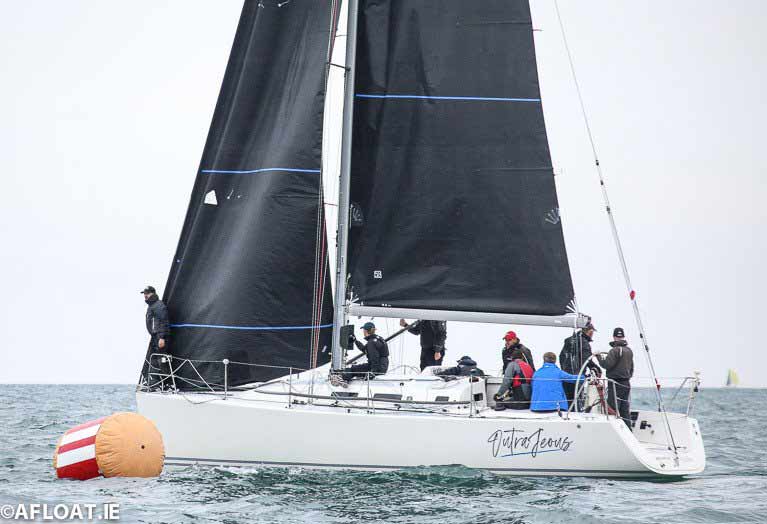 A crewman at the mast of the Howth Yacht Club J109 'Outrajeous' prepares to 'ping the line' using a Racegeek D10
A crewman at the mast of the Howth Yacht Club J109 'Outrajeous' prepares to 'ping the line' using a Racegeek D10
This is our third year and one of consolidation. Half the top 15 boats at the recent SB20 Worlds and a quarter of the J/70 fleet at their World used a d10. We worked with teams before both events to look at their data and set them up for the event. We have a partnership with RS Sailboats for the RS21 and equipped all their boats in the US. A number of the Melges 32s in the US have switched over and we're seeing d10 on the privately-owned IC37s. We had our first sale to a quarter tonner and FarrEast 28.
Probably the craziest boat with a d10 is an Xtreem 40 that's now down in Australia and on the multihull front, we're still working with Piers and the Diam 24s in the UK.
While we focused on the small sports boats in the first couple of years it's great to see take-up across the range of boats we designed the d10 for. The d10 is really the perfect instrument for the whole Irish fleet."
Wicklow IC37 Design Wins on the Hamble
The County Wicklow design of the Melges IC37 by Mark Mills has been named Big Boat Champion on the Hamble after a closely fought series.
It follows a stellar launch of the new Irish marque for the New York Invitational in September where there was Royal Cork success.
Ian Atkin’s Melges IC37 Icy was named the HYS Hamble Winter Series Big Boat Champion, as well as winning the IRC 1 class, at the 38th Hamble Winter Series.
The 2019 edition of the annual Solent series was held over 4 weeks in October by the Hamble River Sailing Club, comprising 8 races in a tightly fought fleet of the UK’s top race boats. The prestigious Hamble Star Trophy was presented to Dr Mark Tomson on behalf of Icy, a trophy originally gifted to the Hamble River Sailing Club in 1934 by the Household Brigade Yacht Club, and now dedicated to the memory of HRSC Secretary Jane Windsor who passed away in the summer.
2019 has been a great first year for the newly arrived Melges IC37 in the UK, winning its Class in a breezy Cowes Week, and then winning the IRC 1 division at a light airs Royal Southern September Regatta counting firsts and seconds.
As a result, dealers Ancasta already have 4 more orders forming the basis of a Solent fleet next summer. The next UK boat (hull #33) will go to Jerry Hill and Carlo Vroon, who commented “We have carefully watched the launch and development of this class, and now having sailed the boat a few times, everything about the boat and the class, just seems right for the UK scene. The boats are very manageable, but rapid downwind and very rewarding when you get it right.”
Anthony O’Leary is Sailor of the Month (Racing) for September
Royal Cork Yacht Club’s Anthony O’Leary’s Bronze Medal in the 20-team New York YC International Invitational at Newport, RI in September is an astonishing achievement when we remember that many of the other top-level Corinthian crews had been practising in the new Mark Mills-designed Melges IC 37s throughout the summer. Yet O’Leary and his Crosshaven squad stepped aboard as strangers to the boat with only a few days to go to the start of a very intense series.
However, his legendary speed abilities with the Cork 1720 Sportsboats under asymmetrics proved to be a great strength, but by the time the series concluded he was steadily climbing the ranks with high-level performance across the board, and the Royal Cork YC’s third overall snatched from the final race was testament to skipper and crew alike.
 Anthony O’Leary (third from left) with his New York bronze medalist crew – skills he first acquired with Cork 1720 Sportsboats transferred well to the new Irish-designed Melges IRC 37
Anthony O’Leary (third from left) with his New York bronze medalist crew – skills he first acquired with Cork 1720 Sportsboats transferred well to the new Irish-designed Melges IRC 37
Wicklow Designed IC37 is 'Perfect Fleet Racing Boat'
Ireland is on the International yacht racing stage this week thanks to triumphs on the water and off at last Saturday's Rolex New York Yacht Club Invitational Cup.
As Afloat reported previously, the Crosshaven, County Cork team led by Anthony O'Leary snatched the bronze medal from Canada in a superlative last day finish while the Kilbride, County Wicklow design team of Mark Mills is celebrating the success of its new IC37s used at the prestigious Big Apple event.
The Invitational Cup produced stunning racing across the full range of conditions for the Club’s fleet of 20 new Mills designed Melges IC37’s. This sixth edition of the biennial Corinthian championship was a true test of talent, teamwork and perseverance over four days and twelve races. After a strong early showing by the San Diego Yacht Club, the Royal Sydney Yacht Squadron came to the fore to win the event on the final day. Six-time participant Royal Cork Yacht Club won the last race to take the final podium placing.
The response to the new IC37 designs has been phenomenal: “A boat that was a surprise. Really technical and fun in all conditions.” Perhaps the highest compliment was made to designer Mark Mills on the lawn at Harbour Court after racing one day: “really the perfect fleet racing boat.” The remarkable spectrum of organisational talent on show by the NYYC to create the event, envisage a new class for it, have 20 of them built, run the racing, and host the competitors is unparalleled.


























